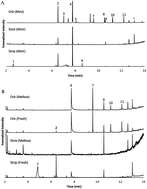Monitoring changes in the chemical composition of dissolvable tobacco products
Abstract
Dissolvable tobacco products are smokeless, spit-free, made from finely milled tobacco, and dissolve in the mouth of a user. In 2009, R.J. Reynolds Tobacco Co. released a line of dissolvable tobacco products in several test markets. In late 2010, the dissolvables were reformulated and several changes in their composition were determined and are reported here. Our analytical approach featured gas chromatography-mass spectrometry preceded by four separate methods for sample preparation: solvent extraction using acetone, trimethylsilyl derivatization of sugars, solid-phase microextraction of semi-volatiles and liquid–liquid extraction for the quantitative analysis of nicotine. Taken together, these methods identified several changes in the formulation of the initial products and their reformulated versions. One major change in the new dissolvables is that “mellow” and “fresh” flavors have been replaced by a “mint” flavor. Additionally, the strips are no longer dominated by glycerol, but rather threitol. Total nicotine and (free nicotine) concentrations for the orbs, sticks, and strips were found to be 3.35 mg g−1 (1.242 mg g−1), 2.6 mg g−1 (0.850 mg g−1), and 2.74 mg g−1 (0.572 mg g−1), respectively. Total nicotine and free nicotine concentrations have significantly increased in some cases.


 Please wait while we load your content...
Please wait while we load your content...